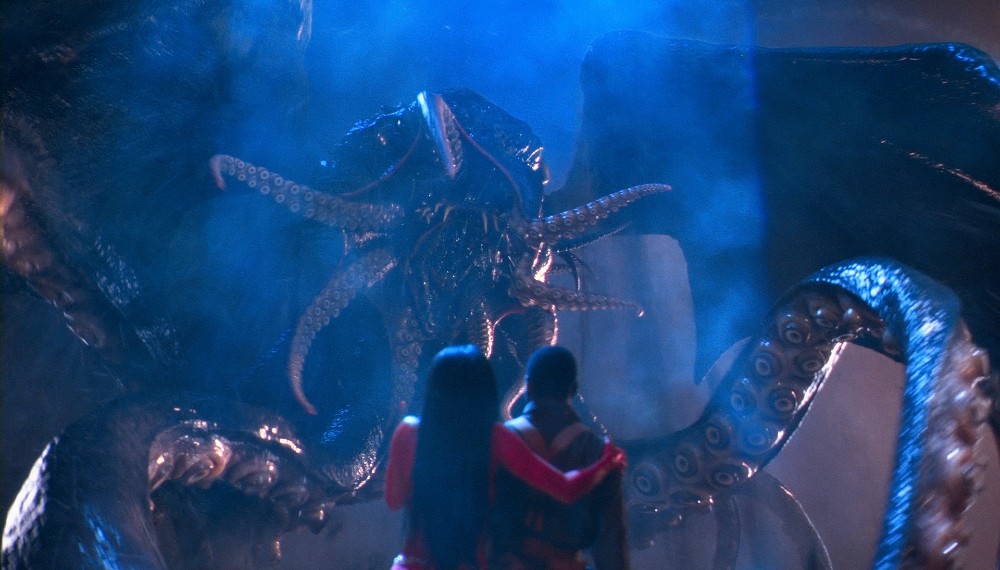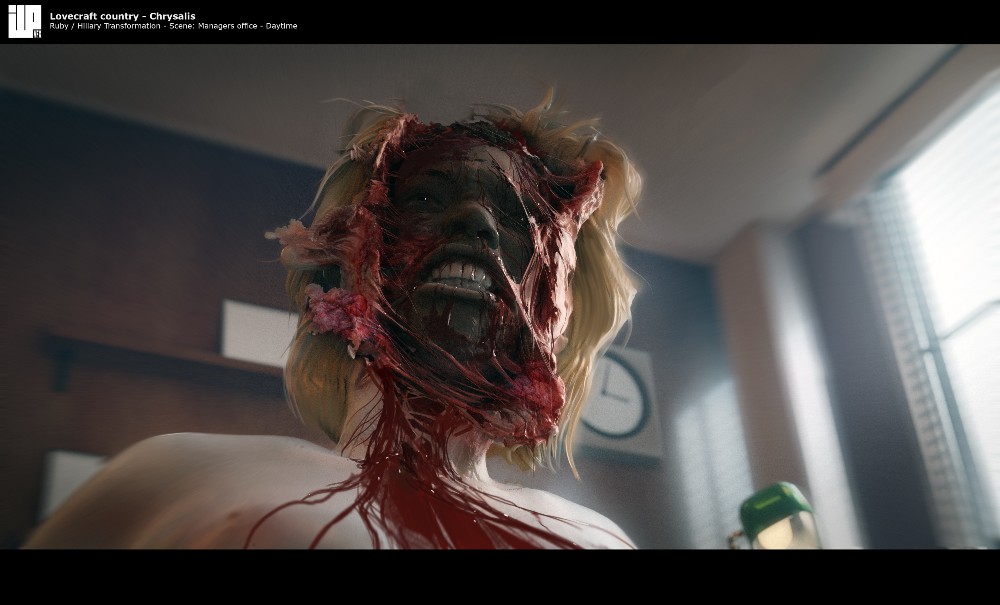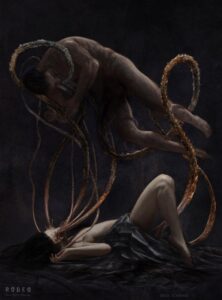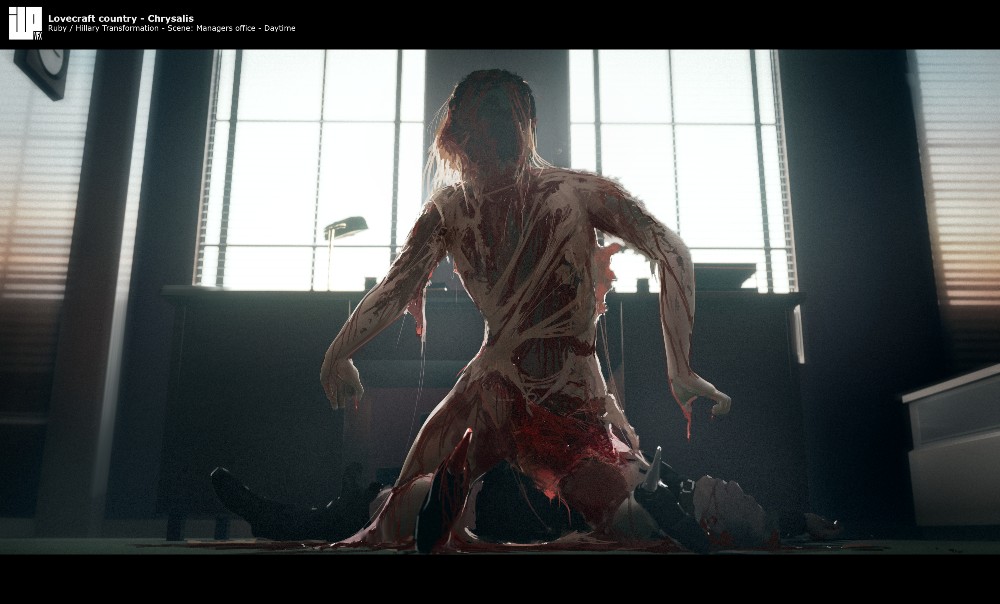
From creator Misha Green comes HBO’s supernatural period piece Lovecraft Country. The show, based on the 2016 novel by author Matt Ruff, explores the combined concepts of horror fiction and racism. The series follows Atticus Freeman (Jonathan Majors) and Leti Lewis (Jurnee Smollett) as they battle racism and monsters in the 1950s while attempting to unlock hidden family secrets with a direct connection to the Braithwhite family and the Book of Names. The show features extraordinary visual effects throughout the 10 ambitious episodes. The visual effects are led by the team from Visual Effects Supervisor Kevin Blank (Lost, Alias). Blank has been nominated for a Primetime Emmy for a total of 5 times for his work on Lost, Fringe, Da Vinci’s Demons, and Lovecraft Country. Other distinguished honors include multiple nominations and accolades from the Visual Effects Society Awards and the Gold Derby Awards.
Blank spoke with Below The Line about all of the different visual effects needed for the show and the challenges of bringing such an ambitious genre-bending project like this to fruition.
The series opens with this extravagant and epic sequence featuring aliens, spaceships, and a major battle. As Blank explained, the opening scene was to set the stage for the audience as to where the series would be going and to illustrate the scale of where the story could go. Given the tone the team needed to set, everything hinged on the initial concept: “The initial concept was that we’re in the trenches and in a war, there’s planes and bullets flying overhead; and then, when we crest to see the valley, it’s just supposed to be warfare. But what we see is surreal flying saucers, giant robots, and creatures. As he moves through the battlefield, we see creatures and Roman soldiers fighting, everything is a big disconnect.” As the scene goes on, each newly introduced fantastical thing illustrates how far in terms of creativity and the strange the story might go. All within the realm of just a few short minutes. From alien women to the arrival of Cthulhu, the scene itself highlights that there is nowhere the team and the story won’t go, “It’s that opening where we have this microcosm of what the show is; which is big and bold elements.” The biggest challenge after that opener, though, involved answering several questions: “How are we going to tie this to African American History, our history, different events, and what’s the take and the twist?”

One of the first challenges to address was how to tackle bringing the Shoggoth creatures to life for the show. Given the clear Lovecraftian influence on the show, with the inclusion of Cthulhu in the show’s first scene, the Shoggoth creature had been interpreted many ways since the creature’s inception. Blank explained that evolutionary decisions were made to evolve the mythology in order to conceptualize the creature for the screen: “The idea that this was a gorilla tiger hybrid, covered with eyes, and then the stabbing instruments from the chest and the piercing tail. They were protecting spirits. We wanted them to be dangerous, highly violent, and give them every killing mechanism possible.” To bring these creatures to life, the art department had Framestore tackle the evolution of the artwork on the Shoggoth. This resulted in the development of two Shoggoth incarnations – the Black and White Shoggoth. “For the white Shoggoth, we were trying to put in a translucent skin so that when it was backlit, we could almost feel that we could see through it. There were different motivations for what that creature was supposed to achieve and that’s what was driving our own creative take on it.” All of this work in bringing the creatures to life required a lot of pre-planning with stunts, the art department, and more, the visual effects supervisor revealed. And it was in getting these cues to line up that provided the team with a lot of work.
The job for the team didn’t get any easier, though, once they moved to more human subjects. Jamie Chung’s character Ji-Ah is based on the Korean Tale of the Nine-Tailed Fox explained Blank, where the creature is meant to be an evil spirit similar to a succubus that has nine fox tails that come out of every place on the body, and this creature, while in the female form, consumes her sexual partners in intercourse. Blank explained further, “Rodeo FX did the visual effects for that sequence and the concept art was done by Deak Ferrand up at Rodeo. He did some spectacular, creepy, awful imagery that was very evocative of what it was.” There was also a major logical challenge once the actors got involved, which the visual effects supervisor dove further into explaining: “How do we get these people in the air and what level of intimacy or nudity are we going to show here. Obviously, hoisting naked people, we hoist them and there’s wires and privacy aspects. There were body replacements, both actors were scanned in their skivvies, and then we could create a digital copy of them that we could match with them. Then connect the CG foxtails, which it’s very easy to call them tentacles, but they’re not because it felt like a big octopus sequence, but it’s their foxtails. Since there are foxtails, they’re covered in fur. They’re coming from orifices of a body or whatever. They’re supposed to be wet and gooey, there was a look development of how that came to pass. How violent were we going to be, what happens when they die, ripping them apart? It was a fast sequence in terms of how much time we had to shoot it.”

The entire process of shooting the scenes between Ji-Ah and Atticus was collaborative and had a lot of moving factors, Blank shared, “There are two competing aspects going on, one is we have naked actors who need to be respected and given free rein to feel comfortable to perform, and then we have this enormously technical exercise where we have secondary cameras that are seeing movements for tracking purposes. It was a bit of a dance.”
A lot of credit was given to Jonathan Majors and Jamie Chung for acting out things that weren’t there and to be open to collaborating and aiding the animators in getting as much as they could to work with: “It required the actors to perform against something that wasn’t there. What was really important was to give them an idea of the force that they were working with because the animators can play the other side of the scene with those foxtails, but they are doing it months later. It was important to watch half of a complete scene and encourage the actors to put tics into their performances, cringes, and things like that. Anything that they did would allow the animators to work with that specifically. The design was pretty great and the actors really brought it.”

Christina Braithwhite transforming to William and Ruby transforming into Dell/Hillary is regarded as one of the most challenging visual effects sequences ever created. The visual effects supervisor enlightened on this, “That particular scene was really bold, crazy, audacious, memorable, and so dramatically daring. It was almost like the metaphor of the show; talking about white privilege, shedding one’s skin, what does it mean to be free, and all these different themes. The execution of the visual effects was a representation of that depiction in a cool way. The visual effects company that did that was Important Looking Pirates and they did a masterful job. The showrunner Misha Green had really unique ideas about what that was, in terms of the William Christina, the two bodies occupying the same space at the same time. That took a lot of concept art and drawing to flesh out what she was getting at. We referenced a lot of things, mostly David Cronenberg’s The Fly, which is Jeff Goldblum’s metamorphosis into something else. Is it a body inside and the skin comes off or it’s another body that’s inside, like a cocoon that’s trying to emerge?”
The visual effects supervisor continued, “Our initial plan was that we were going to have both of them on the ground covered in blood and guts, doing really extreme movements, and their performances would be there. Then we would have these secondary CG pieces of flesh that would be coming off the body, the actors are there and we’re adding bigger scale pieces on top of them in what would be really short shots. Misha came up with the idea later in posts that we wanted to see Christina’s face literally push out of William’s. We scanned them in their skivvies to have digital actors. The intention of having a digital double is to have a placeholder that we can match the real actor and then add our CG elements to it. But what that necessitated us doing was leaning into the quality of our digital doubles, in some cases, what we see is the digital double. It’s completely based off of the performances that the actors gave, but what we’re seeing on screen is not really them, it’s actually an animated CG double of a human being. Many people would say is probably the most complicated thing that can be done in visual effects is to duplicate a human.”
“We had digital doubles of Jordan Patrick Smith, Abbey Lee, Wunmi Mosaku, and Jamie Neumann. We had four digital doubles for all these characters,” Blank revealed. “Each actor performed their aspect separately in the same space. We would have a performance and would cover them with special effects makeup using blood and guts. We had lighting references, performances, and tried to get them to do each side of it. In many cases, digital doubles were created and some scenes are fully CG. The most challenging shot easily was in Misha’s directed episode, “Jig-a-Bobo” where William and Ruby are having sex and she transforms all in one 90 second shot. Initially, we wanted a circular camera coming around those scenes, land in a particular position, and then blow up. That’s the point where we switch the actor. The camera went around a couple times, then it settled.”

“The digital doubles that ILP had done were so successful that there were sections of the shot where we recreated the entire room and recreated both actors,” he said. “Sections of the shot are maybe 7-10 seconds long, everything we are seeing from the room, the people, and the blood and guts is a CG creation. That enables us to move the camera in a more dynamic way to transfer from one actress to the other actress. A lot of times, these scenes need a lot of choreography to figure out in shooting till this point, then someone else is going to come in and we’re going to make a blend. That blend was not a 10 frame or one second moving on someone’s back, which would be a typical thing we would do when making a long-extended shot. It ended up being probably about seven seconds and fully digital environment, people, blood and guts simulations. It’s the biggest, most crazy shot I’ve ever done in my entire career.”
“Morphing is a two-dimensional process. This is a three-dimensional build, where we have to have one person fully built and realized, another person fully built and realized, and an environment fully built and realized. Then making that switch is like I’m a real actor, I’ve changed into a digital actor, there’s another digital actor, and then the environment has gone from a real environment to a digital environment. It’s moved into a different position before we transition back to real actors in a real environment,” the visual effects supervisor emphasized.
When not dealing with the logistical challenges of morphing actors, there was also the matter of reconstructing locations from the ground up. One such location setting that the team had to work visual magic on was Tulsa. Tulsa 1921 was entirely refabricated through the visual effects. The first thing that needed to be done, though, was to find a base to start from in recreating the image of what Tulsa might have looked like during that period: “Our production designer Kalina Ivanov didn’t think that we had the appropriate locations in Atlanta, Georgia for that; so we ended up going to Macon, Georgia. There was a particular street that was more of the period 1920s, something that we could buy for the historical photography.” Historical photographs would become a major asset for the team. “If we look at the historical photographs, streets that were built in the 1920s, pavement wasn’t normal, it was mostly dirt roads and didn’t have big, tall, mature trees. Some things we did to adjust the ground were painting out a lot of these tall trees, which was a big deal technically. We were very focused on wanting to get them to look like the images that Kalina had of Black Wall Street. On that street was a real location hotel; we made a facsimile, not a direct copy, but something that was equivalent to that. We digitally created a version of that. What we have is one street, we’re on two sides of the street, everything on that street was real with real 1910 era cars. The art department basically transformed the street. At the end of the street, there was a very large blue screen, and everything extended beyond that was visual effects. The reverse of that, the same thing, there was a blue screen, which was the hotel that they basically viewed the devastation from and that was completely computer-generated,” Blank shared.
Wrapping up the discussion, Blank pointed out how the last episode of Lovecraft Country involved the most amount of visual effects shots. So many things happen within that final episode, he explained, with the big ceremony at the end as well as everything that happens to Dee. In the case of the big ceremony, one of the biggest issues the team ran into was needing to recreate the Ardham Lodge: “We destroyed that in Episode 2 and then revisited the same location in Episode 10 for the ceremony.” During the ceremony scene, visual effects came into play with needing to highlight the black force energy that pours out of Atticus, but also the arrival of the Black Shoggoth. With the Shoggoth, Blank explained, there was a lot of detail viewers could pick up on: “We could really see his teeth and a lot of the wonderful detail that Framestore put into that was on display up close.” That made moments like when the Shoggoth attacked Dee in the car all the more impactful. Even more so, given how the attack on Dee in the car came to be a Jurassic Park Easter Egg, in how it emulated the T-Rex attacking the kids in the car.
With the news of Lovecraft Country not getting a second season, Blank reflected on his experience in taking on such a project, “It’s a big, bold, crazy show, and it always felt more is more. It was a wonderful playground that Misha came up with and I got to play with some wonderful toys.”
The first season of Lovecraft Country can be viewed via streaming on HBO Max.
All photos courtesy HBO and Rodeo FX. Click on images for larger versions.





